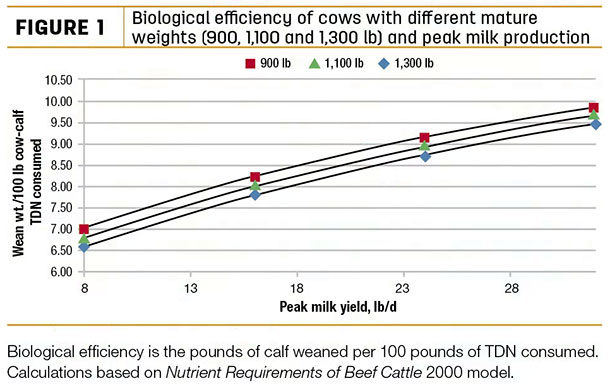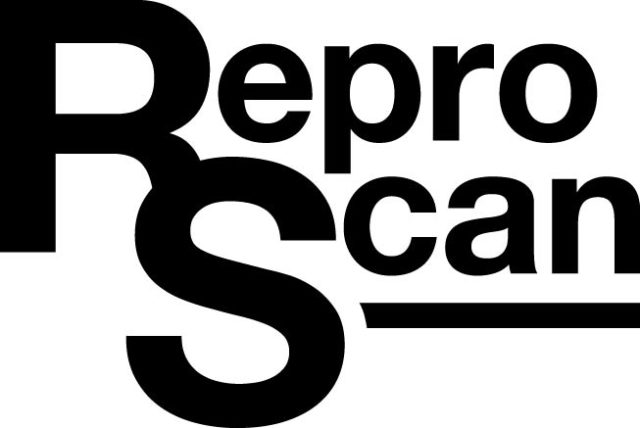Profitability in the cow-calf business, as in most businesses, is largely dependent upon efficiency. Costs associated with feeding the mature beef cow account for 70 percent of variable costs of producing a weaned calf. This means cows that can more efficiently convert feed into pounds of weaned calf are an important way to improve the bottom line.
Cow efficiency has been the discussion of many articles and meetings over the years, focusing largely on cow mature size and milk production. Figure 1 shows how cow mature size and milk production impact biological efficiency of the cow measured as pounds of calf weaned per 100 pounds of total digestible nutrients (TDN) consumed.

That is, how many pounds of calf are produced for every 100 pounds of feed energy.
Milk production
First, greater milk production increases the pounds weaned per 100 pounds of TDN consumed because greater milk production increases output in the form of calf weaning weight more than it increases TDN consumption by the cow. However, biological efficiency is not equal to profit. Forage resources can only support a certain level of milk production in the cow herd.
Genetic potential for milk production above that which forage resources can support will require supplemental feed to keep cows in good body condition. The addition of supplemental feed will likely reduce profit. Therefore, optimum milk production for the environment in the cow herd should be the goal, not maximum milk production.
Cow size
A second factor influencing efficiency is cow size. Smaller cow mature weight increases the pounds of calf weaned per 100 pounds of TDN consumed because smaller cows have lower maintenance energy requirements. Feed TDN required for maintenance should be viewed as a cost to production because those feed nutrients are not being used directly to produce a marketable product.
Reducing cow maintenance requirements can improve efficiency because a cow with lower maintenance requirements uses less feed to produce the same amount of milk. Another way to think about it is: Larger cows must produce more milk than smaller cows to produce the same calf weaning weight per 100 pounds of TDN consumed.
Consider the following example based on Figure 1. Assume two cows are producing 8 pounds of calf weaning weight per 100 pounds of TDN consumed. A 900-pound cow must produce 14 pounds of milk to achieve this while a 1,300-pound cow must produce 17 pounds of milk.
Smaller cows are more efficient due to lower maintenance requirements but, as with milk production, an extremely small cow may have negative consequences on profit because small-frame calves will sell for less at the livestock auction.
Genetic potential for milk production also affects maintenance requirements. Research at the University of Nebraska found cows with above-average genetic potential for milk production have greater maintenance requirements.
Researchers determined the cause to be the greater metabolic rate necessary for increased milk production. Genetic potential for milk production above that which forage resources can support will increase the costs to maintain the cow herd without increasing output in the form of calf weaning weights.
Muscle, fat and visceral organs
A final characteristic of the cow that affects maintenance requirements is the relative amounts of muscle, fat and visceral organs. Muscle accounts for 20 to 25 percent of the maintenance requirement – about three times as much as fat tissue. Muscle mass is energetically costly to maintain because the muscle proteins must be constantly rebuilt.
Research from the University of Minnesota found mature beef cows with lower muscle mass and greater body fat had 25 percent lower maintenance requirements, weaned 1.4 more calves per cow and weaned calves weighing 30 pounds more.
Visceral organs, such as the digestive tract and liver, account for 30 to 40 percent of the maintenance requirement. The size of these tissues is greatly affected by feed intake. As cattle consume more forage and feed, the size of the digestive tract and liver increases, which increases the maintenance requirement. In the University of Minnesota study, the more efficient cows had 10 percent lower visceral organ size.
There are several trends in the cattle industry that could negatively affect biological efficiency and profitability of the cow herd. First, the genetic trends for cow mature weight and ribeye area are increasing such that cows are becoming larger and leaner, which is likely increasing maintenance requirements of the cow herd.
Second, there is a trend in the cattle industry to select cattle that have “capacity,” meaning a wide and deep ribcage as an indication of the ability to consume large amounts of forage. Consumption of large amounts of forage will increase the size of the digestive tract and, thus, increase maintenance requirements.
It would be better to select for cattle that can efficiently digest and convert forage rather than cattle that only consume a lot of forage.
Third, the genetic trend for most beef cattle breeds is for increased milk production, which at first glance would lead to increased weaning weights, but if the genetic potential for milk production is greater than the base forage resources on the ranch can support, supplemental feed costs will increase, negatively affecting profitability. Thus, finding the optimum for these genetic traits rather than the maximum is necessary to maximize biological efficiency and profitability of the cow herd.
This article has focused on a scenario when producers are selling calves at weaning. In Part 2, we will evaluate characteristics that affect efficiency when producers are retaining ownership to slaughter. ![]()

-
Phillip Lancaster
- Assistant Professor - Beef Cattle Production
- Missouri State University
- Email Phillip Lancaster







